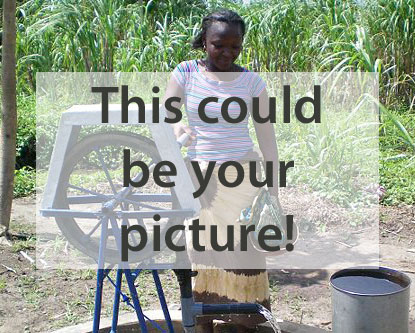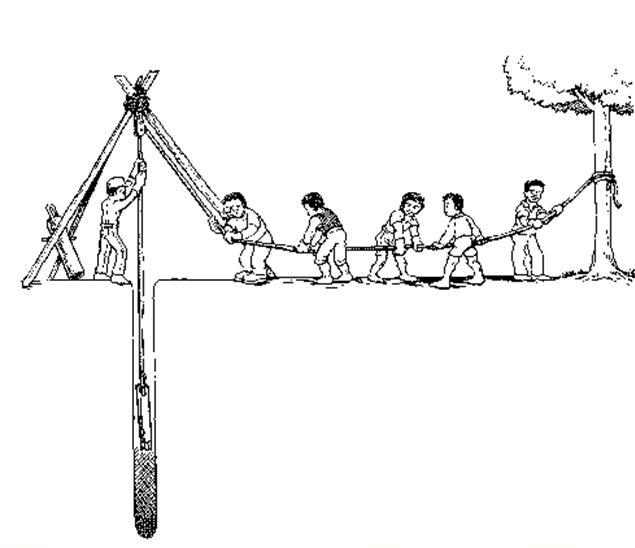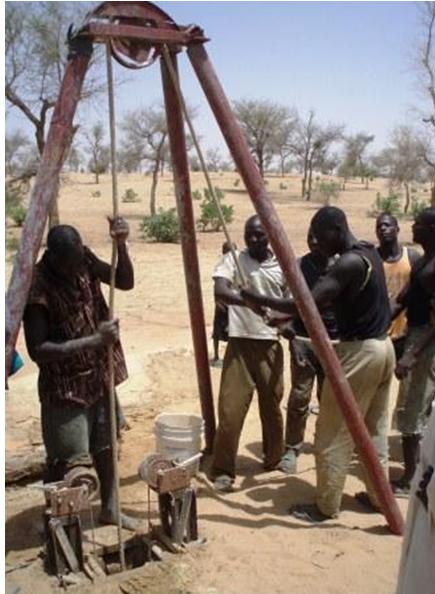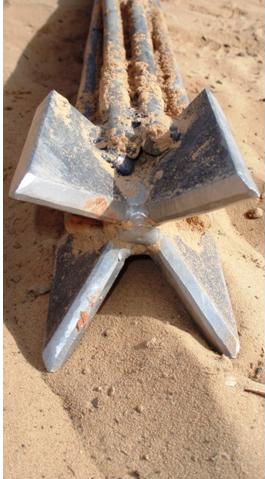Percussion drilling
| |
Percussion drilling is a manual drilling technique in which a heavy cutting or hammering bit attached to a rope or cable is lowered in the open hole or inside a temporary casing. The technique is often also referred to as 'Cable tool'. Usually a tripod is used to support the tools. By moving the rope or cable up and down, the cutting or hammering bit loosens the soil or consolidated rock in the borehole, which is then extracted later by using a bailer. Just as with hand augering, a temporary casing of steel or plastic may be used to prevent the hole from collapsing. When the permanent well screen and casing are installed, this temporary casing has to be removed.
History and social context
Suitable conditions
Percussion drilling is suitable for unconsolidated and consolidated formations: Sand, silt, stiff clays, sandstone, laterite and gravel layers.
Manual percussion drilling is generally used up to depths of 25 meters.
| Advantages | Disadvantages/limitations |
|---|---|
| - Unlike any other drilling method percussion can remove boulders and break harder formations. - Percussion drilling can in principle deal with most ground conditions. |
- The equipment can be very heavy and relatively expensive. - Especially in harder rock the method is slow (weeks, rather than days). |
Technical specification
Operation
Maintenance
Manufacturing
Equipment is commercially produced in western countries. Local production is possible. Percussion drilling is hard work. Use of a small engine may be appropriate.
Cost
Country experiences
Percussion drilling is mainly used in Niger, Nigeria, Chad, Liberia, Ghana, Central America and western countries.
Manuals
- Drilling Wells by Hand, Cliff Missen, Wellspring Africa, draft 4 - Manual on Percussion drilling, well construction, manufacturing tools. Website of WellspringAfrica
- Self-help wells, R.G. Koegel, FAO 1985 - Internet manual on hydrogeology, well constructions, all drilling techniques. Article on percussion.
Movies
Acknowledgements
- The basis for the material on this page was obtained from a desk study shortly to be published on the website of the Practica Foundation, and from the Rural Water Supply Network, and specifically its manual drilling section.
External Links
- Human-Powered Drilling Technologies, Richard Carter, Cranfield University, 2005 - An overview of human-powered drilling technologies - Download.
- Drilling Boreholes for Hand pumps, Peter Wurzel, SKAT Switzerland, 2001 - A book on hydrogeology, well construction, drilling techniques, well development - Download. Website of SKAT
- Low-cost shallow tube well construction in West Africa, M. Sonau, FAO - An overview of shallow tube well drilling techniques - website. Website of FAO documents.
- Technical note 43. Simple drilling methods, Bob Elson and Rod Shaw, WEDC - An overview of simple drilling methods Download. Website of Loughborough University Technical Briefs section. Website of Loughborough University WELLS.
- A Water Handbook, Technical Guidelines Series, UNICEF, 1999 - Programming and implementation. Download.
- Technology notes, section 7; Tube wells and boreholes, WaterAid - An overview of human-powered drilling technologies. Download. Website of Wateraid.org.
- Water for the World, Technical note series rws 2, USAID 1982 - Technical notes on methods of developing of groundwater, manual drilling techniques. Website Livewater International. Under 'Cable Tool Wells'.
- Multi-service procedures for well-drilling operations, field manual chapter 9, US Military Chapter 9, alternative well construction, manual drilling techniques - Download.
Suppliers
- Eijkelkamp Agrisearch Equipment - Drilling equipment and manuals on hand auger and percussion gouges - http://www.eijkelkamp.nl
- Van Reekum Materials - Drilling equipment, hand auger and percussion drilling - http://www.reekum.nl
References

|



